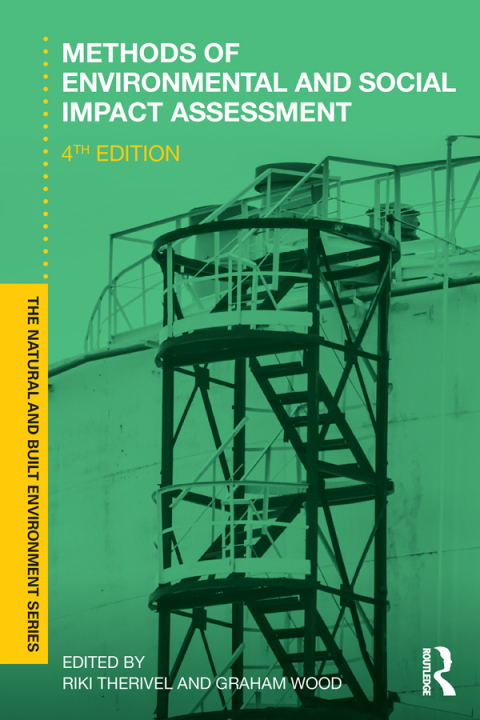Description
Efnisyfirlit
- Cover
- Half Title
- Title Page
- Copyright Page
- Dedication
- Table of Contents
- Contributors
- 1 Introduction
- 1.1 Environmental and Social Impact Assessment (ESIA) and the aims of the book
- 1.2 The ESIA process
- 1.3 The broader context for ESIA
- 1.4 Book structure
- 2 Water
- 2.1 Introduction
- 2.2 Definitions and concepts
- 2.3 Key legislation, guidance and standards
- 2.4 Scoping
- 2.5 Baseline
- 2.6 Impact prediction and evaluation
- 2.7 Mitigation
- 2.8 Monitoring
- 2.9 Conclusions
- 3 Soils, land and geology
- 3.1 Introduction
- 3.2 Definitions and concepts
- 3.3 Key policy and legislation
- 3.4 Scoping and baseline studies
- 3.5 Impact prediction
- 3.6 Mitigation
- 3.7 Monitoring
- 3.8 Conclusions
- 4 Air
- 4.1 Introduction
- 4.2 Definitions and concepts
- 4.3 Key international guidelines and standards
- 4.4 Scoping and baseline studies
- 4.5 Impact prediction and evaluation
- 4.6 Mitigation and enhancement
- 4.7 Monitoring
- 4.8 Conclusions
- 5 Climate and climate change
- 5.1 Introduction
- 5.2 Definitions and concepts
- 5.3 Key legislation, guidance and standards
- 5.4 Scoping and baseline studies
- 5.5 Impact prediction and evaluation
- 5.6 Mitigation and monitoring
- 5.7 Conclusions
- 6 Ecology
- 6.1 Introduction
- 6.2 Definitions and concepts
- 6.3 Key legislation, guidance and standards
- 6.4 Defining the baseline – scoping
- 6.5 Defining the baseline – desk studies and surveys
- 6.6 Detailed surveys and evaluation of baseline conditions
- 6.7 Impact prediction and evaluation
- 6.8 Mitigation
- 6.9 Monitoring
- 6.10 Conclusions
- 7 Coastal ecology and geomorphology
- 7.1 Introduction
- 7.2 Definitions and concepts
- 7.3 Key legislation, policies and guidance
- 7.4 Scoping and baseline studies
- 7.5 Impact prediction and evaluation
- 7.6 Mitigation
- 7.7 Monitoring
- 7.8 Conclusions
- 8 Ecosystem services
- 8.1 Introduction
- 8.2 Definitions and concepts
- 8.3 Key policy, legislation, guidance and standards
- 8.4 Scoping and baseline studies
- 8.5 Impact prediction and evaluation
- 8.6 Mitigation and enhancement
- 8.7 Monitoring
- 8.8 Conclusions
- 9 Noise
- 9.1 Introduction
- 9.2 Definitions and concepts
- 9.3 Key legislation, guidance and standards
- 9.4 Scoping and baseline studies
- 9.5 Impact prediction and evaluation
- 9.6 Mitigation
- 9.7 Monitoring
- 9.8 Conclusions
- 10 Transport
- 10.1 Introduction
- 10.2 Definitions and concepts
- 10.3 Key guidance
- 10.4 Scoping and baseline studies
- 10.5 Impact prediction and evaluation
- 10.6 Mitigation
- 10.7 Monitoring
- 10.8 Conclusions
- 11 Landscape and visual
- 11.1 Introduction
- 11.2 Definitions and concepts
- 11.3 Key legislation and guidance
- 11.4 Scoping and baseline studies
- 11.5 Impact prediction and evaluation
- 11.6 Mitigation and enhancement
- 11.7 Monitoring
- 11.8 Conclusions
- 12 Cultural heritage
- 12.1 Introduction
- 12.2 Definitions and concepts
- 12.3 Key legislation, guidance and standards
- 12.4 Baseline studies
- 12.5 Impact prediction and evaluation
- 12.6 Interactions
- 12.7 Mitigation and enhancement
- 12.8 Monitoring
- 12.9 Conclusions
- 13 Socio-economic impacts 1: Overview and economic impacts
- 13.1 Introduction
- 13.2 Definitions and concepts
- 13.3 Key legislation, guidance and standards
- 13.4 Scoping and baseline studies
- 13.5 Impact prediction and evaluation: direct and indirect employment impacts
- 13.6 Mitigation and enhancement
- 13.7 Monitoring
- 13.8 Conclusions
- 14 Socio-economic impacts 2: Social impacts
- 14.1 Introduction
- 14.2 Definitions and concepts
- 14.3 Key legislation, guidance and concepts
- 14.4 Scoping and baseline studies
- 14.5 Impact prediction and evaluation
- 14.6 Mitigation and enhancement
- 14.7 Monitoring
- 14.8 Conclusions
- 15 Land acquisition, resettlement and livelihoods
- 15.1 Introduction
- 15.2 Definitions, concepts, key guidance/standards
- 15.3 Outline of the resettlement process
- 15.4 Scoping and initial planning
- 15.5 Profiling and baseline data collection
- 15.6 Development of the Resettlement Action Plan (RAP)
- 15.7 Implementation and handover
- 15.8 Livelihood restoration and enhancement
- 15.9 Monitoring and evaluation
- 15.10 Conclusions
- 16 Health
- 16.1 Introduction
- 16.2 Definitions and concepts
- 16.3 Key legislation, guidance and standards
- 16.4 Screening and scoping for HIA
- 16.5 Assessment for HIA
- 16.6 Mitigation/enhancement and monitoring for HIA
- 16.7 Human Health Risk Assessment
- 16.8 What capabilities are needed to undertake HIA?
- 16.9 Conclusions
- 17 Resource efficiency
- 17.1 Introduction
- 17.2 Definitions and concepts
- 17.3 Key legislation, guidance and standards
- 17.4 Scoping and baseline studies
- 17.5 Impact prediction and evaluation
- 17.6 Mitigation
- 17.7 Conclusions
- 18 Risk and risk assessment
- 18.1 Introduction
- 18.2 Definitions and concepts
- 18.3 Prediction and evaluation
- 18.4 Mitigation
- 18.5 Beyond QRA and qualitative risk assessment?
- 18.6 QRA and ESIA
- 18.7 Conclusions
- 19 Cumulative effects
- 19.1 Introduction
- 19.2 Definitions and concepts
- 19.3 Key legislation and guidance
- 19.4 Scoping and baseline
- 19.5 Prediction and evaluation
- 19.6 Mitigation
- 19.7 Monitoring and management
- 19.8 Conclusions
- 20 Environmental and social management plans
- 20.1 Introduction
- 20.2 Definitions and concepts
- 20.3 Key legislation, policy and guidance
- 20.4 Developing an ESMP
- 20.5 Conclusions
- Glossary
- Index





